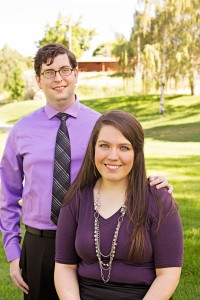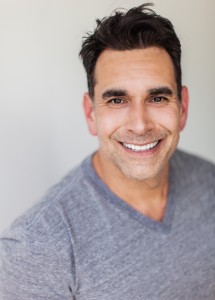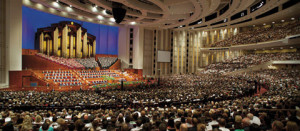Podcast: Download (80.2MB)
Subscribe: RSS
Dealing with gender dysphoria: Finding inner peace through Christ – An interview with Kyle and Amy Merkley. To read Kyle’s story and be introduced to the Journey’s of Faith Project from NorthStarLDS, click here.
 Kyle is the oldest of five children. He grew up in an amazing family and he’s grateful for the strength his family gives him. Kyle is currently attending graduate school at Brigham Young University studying Classical Languages and Literature. He loves literature and loves sharing this love of literature with others. Music has always been a huge part of his life and he plays trumpet, piano, and organ. Kyle has been married for almost five years to Amy who is one of the most amazing women in the world. She helps him to be a better person every day. Kyle loves reading, watching chick flicks, shopping with his wife, and all things nerdy.
Kyle is the oldest of five children. He grew up in an amazing family and he’s grateful for the strength his family gives him. Kyle is currently attending graduate school at Brigham Young University studying Classical Languages and Literature. He loves literature and loves sharing this love of literature with others. Music has always been a huge part of his life and he plays trumpet, piano, and organ. Kyle has been married for almost five years to Amy who is one of the most amazing women in the world. She helps him to be a better person every day. Kyle loves reading, watching chick flicks, shopping with his wife, and all things nerdy.
Kyle is here with his wife Amy to talk about their very unique circumstances. For the sake of our conversation today, those unique circumstances will likely focus on the topic of Kyle identifying as being transgender or experiencing gender dysphoria. Kyle has contributed to a new project of the group NorthStar LDS entitled Journeys of Faith – The Journeys of Faith Project is a growing repository of personal essays by Latter-day Saint individuals and families wrestling with issues related to gender identity (e.g., gender dysphoria and/or transgenderism) and are striving to find congruence and peace within the context of the gospel of Jesus Christ.
RiseUp is a podcast designed to offer answers and frameworks for youth, or young adults who are seeking answers to difficult or critical questions about LDS Culture and doctrine.
Questions addressed in this episode:
There is so much to learn and absorb with the topic of being transgender or experiencing gender dysphoria, but let’s first set some foundational items for the basis of our getting to know you and some of the challenges that you face starting with the terms, the lexicon of words that are most welcome to be used when dealing with this subject. What does it mean to be transgender, and what does it mean to experience gender dysphoria in perhaps a more clinical or text book sense?
In your essay on the Journeys of Faith project, entitled: Jesus Wins: Finding Faith in Ambiguity” you express some concepts that may sound familiar to some teenagers in some respects, but maybe not in others. If you could talk about your experience with mirrors growing up.
With your specific life scenario, you were born a genetic male. When did you feel that just didn’t fit your mind’s eye of yourself?
How did your parents respond to this scenario?
It’s important to make the distinction, that in your experience, the thoughts you had were not related to sexual urges or attraction, per se, but just how you saw yourself.
Being a teenager is typically defined in some part with the experience of self-discovery, and the challenges that arise when your body goes through certain biological changes, as well as social independence. But here you are, with another layer to that, something very uncharted in the Mormon experience. In your essay you state that the atonement of Jesus Christ gave you hope, particularly Moroni 10:32 “Yea, come unto Christ, and be perfected in him, and deny yourselves of all ungodliness; and if ye shall deny yourselves of all ungodliness, and love God with all your might, mind and strength, then is his grace sufficient for you, that by his grace ye may be perfect in Christ…”
Music also became a part of your life a coping mechanism. We are both trumpet players as I understand it.
So, even with all that was going on with your life you decided to attend BYU as opposed to perhaps some other university where being transgender would be more either present, accepted, if not encouraged to a certain extent.
BYU led you to a mission call to the California Anaheim Mission. Opening that letter, Dear Elder Kyle Merkley. How did that feel to read that, given your trials and circumstances up to this point? Did you see this as a point of success, of achievement to even feel ready to put in your papers?
In your essay you state: “While serving a mission was really hard in some ways (I had to deal with constant depression, and living with all guys triggered my gender dysphoria), I found serving a mission also clearly defined a role for me. I didn’t have to struggle with the question of who I was. I was told exactly who I was and how I was supposed to act every day. It was that sense of purpose which kept me going.”
It was on your mission that you actually first learned the name for what you were experiencing, or at least a term that has been assigned to those experiencing similar emotions, transgender.
At some point you describe studying for hours, days, weeks, what have you, to find some guidance on what it means to be Transgender and a member of the Church of Jesus Christ of Latter-day Saints, and you kind of snap under the cognitive dissonance, or maybe it would be vacuum of space where questions remained unanswered.
In all this there were some coping mechanisms that you installed, some self-medication that served as a sort of pressure release for all that you were feeling. What were some of those things?
This is when Amy your now wife enters the picture. I have hears some very dear things about Amy, I can’t wait to hear her side of things. How did you two meet?
Kyle has some incredibly tender words to describe what you meant to him, “She asked me out when I didn’t have the self-confidence to ask anyone out. She liked me when I couldn’t find the strength to like myself. And eventually, she loved me when all I felt inside was self-loathing. When we started dating she brought happiness back into my life. Every time I was around her, I felt so right—a rightness I’d been searching for my whole life. She made the pain of gender dysphoria recede into the background. She brought light and color back into a world which was colorless and bleak. She gave me hope. She loves life so much and finds joy in so many little things. Every time I was with her I found little joyful reasons to love life as well. As we dated, she began the process of healing my broken spirit.”
Amy, when did you know this is what you meant to Kyle? When were you opened up to what Kyle was feeling?
You wrote a letter to Amy explaining what was going on, what was in that letter? Is that something public or too personal to be public?
That reprieve from the gender dysphoria came back three months after you were married. What happened? How did you choose to respond?
Here you are today, still together, and now putting your story out there in an effort to help others, to strengthen others to stay true, to know that there is an answer in the gospel of Jesus Christ, and the atonement is stronger than some of the most discouraging trials one can face.
Now that we know your story, and what an amazing story it is and will continue to be, the next little bit I would love to get some insights or suggestions both for those who may be experiencing gender dysphoria themselves, as well as for their family, friends, and even ecclesiastical leaders in order to help all understand this issue more fully, but also to find a path of faith, a journey of faith that includes gender dysphoria.
Starting with those who are experiencing gender dysphoria, if you haven’t already said it in the telling of your story, what would you say to the person listening that may be in that place? Kyle I would like you to answer first, and then Amy, if you could also have a response for that same person.
You go on to say in this essay, “I don’t always know how to deal with the pain of having gender dysphoria, and I constantly wonder how my identity as transgender fits with my identity as a member of the Church of Jesus Christ of Latter-day Saints.” I think members of the Church are in the same place, we don’t always know what to think or how to respond. I can think of the bishop sitting in his office and having someone come to them and say, Bishop, I think I am transgender, and that Bishop going, hmm… what does the handbook say about this? I have looked, and it’s currently blank on this issue. There are issues relating to chastity in which one may make some educated and hopefully inspired decisions, but it is one of those points where we will believe what God will reveal with respect to this issue, but until then, perhaps you could give your advice to a bishop or stake president that is approached with this issue and wants to do so with love, but also inspired guidance.
Perhaps you would be willing to provide some answers and insight you have received as you have fasted and prayed, in an effort to reconcile the lack of information in church manuals and scriptural sources on gender dysphoria specifically, with things like the Family: A Proclamation to the World which clearly asserts the teachings on gender.
Moving forward on the right path, or the choice you have made to remain faithful to your covenants; how does one live by faith when approaching gender dysphoria or being transgender?
Kyle and Amy Merkley are defining what it means to be on a journey of faith. We will post a link to Kyle’s essay as part of the Journeys of Faith project from NorthStarLDS, we encourage all to read it and come to feel the spirit of Kyle’s testimony. Please feel free to share this message with others as part of an effort to show forth love and support, to do as Elder Christofferson encouraged in the April 2015 general conference, to march with those who are experiencing gender dysphoria, and to extend a hand of fellowship as a way of building a zion people.




